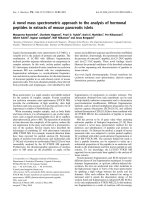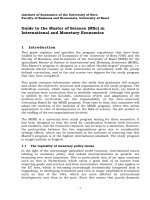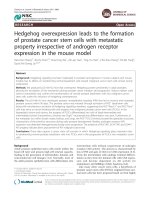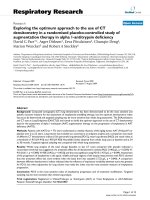Part i organic reactions in non conventional solvents part II new approach to the formation of bishomoallylic alcohols synthesis of (r) sulcatol
Bạn đang xem bản rút gọn của tài liệu. Xem và tải ngay bản đầy đủ của tài liệu tại đây (3.5 MB, 228 trang )
PART I:
ORGANIC REACTIONS IN NON-CONVENTIONAL
SOLVENTS
PART II:
NEW APPROACH TO THE FORMATION OF
BISHOMOALLYLIC ALCOHOLS – SYNTHESIS OF (R)-
SULCATOL
CHEN SHUI LING
(B.Sc. (Hons.), NUS)
A THESIS SUBMITTED
FOR THE DEGREE OF DOCTOR OF PHILOSOPHY
DEPARTMENT OF CHEMISTRY
NATIONAL UNIVERSITY OF SINGAPORE
2005
Acknowledgements i
Acknowledgements
I would like to thank the following people for their advice and assistance,
without whom this project would not have been possible:
My supervisor, Professor Loh Teck Peng, for giving me the opportunity to
work in his research laboratory and for his invaluable guidance. The six years that I
have spent working with him, since my undergraduate days, have been a truly
rewarding learning experience. The trust and confidence that he has in me, formed the
bedrock of motivation that sustained me through the end of my graduate study.
My two mentors, Kee Leng and Qiying, for their practical guidance and
training at the beginning of my research study. Their patience and encouragement are
truly precious.
Pek Ling, my dearest ex-roommate, who gives me a lot of positive advice and
moral support. Her thoughtfulness and kindness are truly dear to me.
Hin Soon, Ken and Kok Ping for their invaluable advice, discussion and
inspiration throughout this period.
There is also Jingmei, Nizam, Angeline, Yong Chua, Ai Hua, Bee Man, Shu
Sin, Kui Thong, Yujun, Zhiliang and Manjing, thank you for making me feel very
much at home.
I would also like to thank the Singapore Millennium Foundation, Ltd. for the
research scholarship.
Finally, I am grateful to my family, especially my parents. Without them, I
will not be where I am today.
Table of Contents ii
Table of Contents
Acknowledgement
i
Table of Contents
ii
Summary
v
List of Abbreviations
ix
Part I Organic Reactions in Non-Conventional Solvents
1
Chapter 1
Introduction 2
1.1 Introduction 3
1.2 Green Chemistry 5
1.3 Water
7
1.4 Ionic Liquids 9
Chapter 2
Asymmetric Mannich-Type Reaction 14
2.1 Introduction – Mannich-Type Reaction
15
2.2 Our Approach
23
2.3 Results and Discussion
2.3.1 InCl
3
-Catalyzed Three-Component Asymmetric
Mannich-Type Reaction in Methanol
25
2.3.2 Asymmetric Mannich-Type Reactions Catalyzed by
Indium(III) Complexes in Ionic Liquids
34
2.3.3 Asymmetric Three-Component Mannich-Type
Reaction in Water: Design, Synthesis & Application of
A New Chiral Auxiliary
40
Chapter 3
Mukaiyama Aldol Reaction in Ionic Liquids 60
3.1 Introduction − Mukaiyama Aldol Reaction
61
3.2 Results and Discussion
3.2.1 Mukaiyama Aldol Reaction using Ketene Silyl Acetals
with Carbonyl Compounds in Ionic Liquids
62
Table of Contents iii
3.2.2 A Newly Designed Polar Ionic Liquids for highly
efficient Mukaiyama Aldol Reaction
66
3.2.3 Development of Asymmetric Mukaiyama Aldol
Reaction
70
Chapter 4
Conclusion
72
Part II
New Approach to The Formation of Bishomoallylic Alcohols –
Synthesis of (R)-Sulcatol
75
Chapter 1
Nickel-Catalyzed Homoallylation
76
1.1 Introduction 77
1.2 Nickel-Catalyzed Homoallylation
79
1.3 Results and Discussion
86
Chapter 2
A Highly Efficient Chemical Kinetic Resolution of
Bishomoallylic Alcohols: Synthesis of (R)-Sulcatol
90
2.1 Introduction − Kinetic Resolution of Alcohols
91
2.2 Results and Discussion
102
2.3 Further Application of The In(OTf)
3
-Catalyzed Chemical
Kinetic Resolution – Synthesis of (R)-(−)-
α
-Curcumene via
Iron-Catalyzed Cross Coupling Reactions
113
Chapter 3
Conclusion
117
Experimental Section 118
General Information
119
Materials
120
Chromatography
121
Instruments
123
Procedures and Data – Part I
Chapter 2 Asymmetric Mannich-Type Reaction
125
Chapter 3 Mukaiyama Aldol Reaction in Ionic Liquids
158
Procedures and Data – Part II
Chapter 1 Nickel-Catalyzed Homoallylation
171
Table of Contents iv
Chapter 2 A Highly Efficient Chemical Kinetic Resolution
of Bishomoallylic Alcohols: Synthesis of (R)-
Sulcatol
187
Publication List
216
Summary v
Summary
Part I: Organic Reactions in Non-Conventional Solvents
Asymmetric Mannich-type reaction in methanol and ionic liquids, respectively,
using indium(III)-complexes as catalyst was successfully accomplished (Scheme 1).
Using methanol or ionic liquids, the Mannich-type reaction works well with both
enolizable and non-enolizable aldehydes as well as aliphatic amines. It was found that,
after the reaction, the indium(III)-complexes could be recovered and reused.
+
NH
R
1
OMe
O
R
1
H
O
MeO
2
C
NH
2
MeO
2
C
r.t., overnight
*
up to > 99% de
MeOH or ionic liquids
OSiMe
3
OMe
In(III)-complexes
Scheme 1. In(III)-complexes-catalyzed asymmetric Mannich-type reaction.
In our investigation, derivatives of natural compounds, L-amino acids, were
used as chiral reagents in the asymmetric Mannich-type reaction. We found that L-
valine methyl ester was an excellent chiral reagent. Using L-valine methyl ester as the
chiral amine, high diastereoselectivities (up to 99% de) were obtained.
The design and synthesis of a new chiral auxiliary 3a (Figure 1) for the
asymmetric Mannich-type reaction in water was reported. The chiral auxiliary was
synthesized in five steps from commercially available 2,3-dihyroxysuccinic acid
dimethyl ester. Preliminary studies using the chiral auxiliary were carried out under
Summary vi
both anhydrous and aqueous conditions, catalyzed by indium trichloride. Yields of the
reactions were good but selectivities were only moderate.
The chiral auxiliary was also successfully attached onto the amine component
for the investigations of the three-component Mannich-type reactions (Figure 1). The
X-ray crystal structure of the chiral amine 14 showed that the phenyl group of the
chiral auxiliary, although positioned in the same direction as the amine functionality,
was not able to block one face of the amine group completely. Thus, this explained
the low selectivity of the reactions.
O
NPh
O
14
NH
2
R
R
NPh CF
3
O
HO
O
R
R
3a
CF
3
O
Figure 1. Chiral auxiliary 3a and chiral amine 14.
In chapter 3, we reported the first Mukaiyama aldol reaction using [omim]Cl
in the absence of catalyst. This method works well with a wide range of aldehydes
and gives the aldol products in moderate yields (Scheme 2).
R
2
R
3
OTMS
R
1
O
H
+
OH
R
2
O
R
1
R
3
N
N
Cl
-
7
R
R
Scheme 2. Mukaiyama aldol reaction using [omim]Cl.
Summary vii
To increase the effectiveness of this system, we designed a polar ionic liquid
15 by mixing [hmim]Cl and ionic solid 14 (Scheme 3). Using this newly designed
ionic liquid 15, we successfully increased the efficiency of the Mukaiyama aldol
reaction. The reusability of the ionic liquid 15 has also been demonstrated.
N N
Cl
5
+
New ionic liquid, 15
N
N
Br
N
N
Br
6
14
Scheme 3. The newly designed ionic liquid 15.
Summary viii
Part II: New Approach to the Formation of Bishomoallylic Alcohols – Synthesis of
(R)-Sulcatol
The regioselectivitives of nickel-catalyzed homoallylation using 4-
methylpenta-1,3-diene with various aldehydes has been studied. The versatility of the
bishomoallylic alcohols encouraged us to develop an asymmetric method to
synthesize this class of alcohols. We have successfully established a highly effective
chemical kinetic resolution of bishomoallylic alcohols (Scheme 4). A remarkable
remote 1,4-stereo communication in In(OTf)
3
-catalyzed oxonium ene-type cyclization
was unveiled. Based on this stereochemical feature, the racemic mixture of
bishomoallylic alcohols was resolved in high enantioselectivities. The effectiveness of
this kinetic resolution was demonstrated in a one-step synthesis of (R)-sulcatol with
over 98% ee. Although high enantioselectivities were achieved, there were some
limitations of this kinetic resolution. Efforts were done to overcome these limitations.
O
R
St
CHO
St
R
OH
racemic
R
OH
+
recover
In(OTf)
3
CH
2
Cl
2
resolved alc >99% ee
Scheme 4. A highly effective kinetic resolution of bishomoallylic alcohols.
List of Abbreviation ix
List of Abbreviations
*Aux chiral auxiliary
Ac acetyl
acac acetylacetonate
Anhyd. anhydrous
Ar aryl
atm atmospheric pressure
br broad singlet
c concentration
cald calculated
COSY Correlation Spectroscopy
CSA camphorsulfonic acid
°C
degree centigrade
d doublet
dd doublet of doublets
de diastereomeric excess
DEPT Distortionless Enhancement by Polarization Transfer
DMAP 4-N,N-dimethylamino pyridine
DMF N,N-dimethylformamide
DMSO dimethyl sulfoxide
dt doublet of triplets
ee enantiomeric excess
EDC 1-ethyl-3-(3-dimethylamino propyl)carbodiimide
EI electron-impact ionization
equiv. equivalent(s)
ESI electrospray ionization
Et ethyl
Expt experiment
FGI Functional group interconversion
FTIR fourier transform infrared spectrometry
g gram
List of Abbreviation x
h hour(s)
hex n-hexane
HPLC high performance liquid chromatography
HRMS high resolution mass spectrometry
Hz hertz
i-Pr isopropyl
IUPAC International Union of Pure and Applied Chemistry
J coupling constant
M molar concentration
m multiplet
m/z mass per charge ratio
M
+
parent ion peak (mass spectrum)
Me methyl
MHz mega hertz
min minute(s)
mL millilitres
µ
L
microlitres
mmol millimole
mol% mole percent
MS mass spectrometry
ms molecular sieves
nm nanometres
NMI N-methylimidazole
NMR Nuclear magnetic resonance
NOE Nuclear Overhauser enhancement
Nu nucleophile
OTf trifluoromethanesulfonate (triflate)
p para
Ph phenyl
ppm parts per million
Pr propyl
py pyridine
q quartet
List of Abbreviation xi
qn quintet
R
f
retention factor
R
t
retention time
rbf round-bottom flask
rt room temperature
s singlet
t triplet
td triplet of doublets
THF tetrahydrofuran
THP tetrahydropyrane
TLC thin layer chromatography
TMS trimethylsilyl
Tf Trifluoromethanesulfonyl
Ts p-toluenesulfonyl (tosyl)
TSA p-toluenesulfonic acid
tt triplet of triplets
UV ultraviolet
vol. volume
Part I
Organic Reactions in Non-Conventional Solvents
Chapter 1
Introduction
Chapter 1 Introduction
Part I : Organic Reactions in Non-Conventional Solvents 3
1.1 Introduction
Chemistry, through profound to many individuals, is constantly in close
contact with our daily life. From a shopping carrier which we often take for granted,
to advanced therapeutic medicines for chronically ill patients, knowledge in chemistry
is critical in development of technologies and materials that can make significant
impact in life of human beings.
Organic synthesis is one of the most important branches of chemistry. It plays
an important role in the process of making carbon-based materials such as
pharmaceuticals that can cure or prevent diseases, antifertility agents for population
control, insecticides, pesticides, plant and animal hormones to increase food
production and nutritional quality, polymers, fabrics, dyes and cosmetics.
Despite extensive global research effort, most of the organic reactions are still
carried out in conventional organic solvents. The use of organic solvents is extremely
widespread in industry and, while the degree of hazard may vary, all solvents are
considered potentially hazardous. The toxicities of some of the conventional organic
solvents are listed as followed:
1
(1) Benzene – It is a known carcinogen. Short-term exposure to high levels of
benzene causes drowsiness, dizziness, loss of conciousness and death.
(2) Carbon tetrachloride / chloroform – Both of these agents induce significant
hepatotoxicity, including terminal liver and kidney necrosis.
1
J.T.Baker Material Safety Data Sheets on
Chapter 1 Introduction
Part I : Organic Reactions in Non-Conventional Solvents 4
(3) Methylene chloride – Exposed workers are subject to developing heart disease.
It also causes several types of tumors in animals and is considered
carcinogenic by the International Agency for Research on Cancer. Methylene
chloride is metabolized to carbon monoxide.
(4) Toluene – Tremor, ataxia and memory impairment are the most common
reported symptoms, but cardiac arrhythmias, decrease sense of smell, optic
atrophy, hearing impairment, and peripheral neuropathy may also occur.
Long-term exposure has been associated with neuropsychiatric symptoms.
(5) N,N-dimethylformamide – it causes teratogenic (produces physical defects in
unborn) animals.
(6) Ethyl ether – Primary effect of exposure is narcosis and general anaesthesia. It
is hepatatoxic (toxic to liver).
In addition, the synthesis of materials or drugs is often focused on yield,
quality and efficiency. When the technology is transferred from laboratory to plant
scale, disposal of waste chemicals may be a painstaking issue. If not handled carefully,
this may cause serious environmental problems such as pollutions and unseating the
ecological system.
With this awareness, the discovery of more efficient and safer methods is
hence most welcomed. Therefore, the development of more environmentally friendly
reactions is much sought after.
Chapter 1 Introduction
Part I : Organic Reactions in Non-Conventional Solvents 5
1.2 Green Chemistry
The Green Chemistry Movement was started by the US Environmental
Protection Agency (EPA), aiming to encourage both industry and academia to use
concepts in chemistry for pollution prevention. The goal of green chemistry is to
reduce the hazards associated with products and the processes that are essential not
only to maintain the quality of life achieved by society through chemistry, but also to
further advance the technological achievement of chemistry.
Green Chemistry
2
is considered as the most important framework in
accomplishing pollution prevention. Pollution prevention is an approach to address
environmental issues that involves prevention of waste production. By offering
environmentally benign alternatives to replace industrial processes that often involve
toxic chemicals, green chemistry promotes pollution prevention at the molecular level
in a variety of ways, such as using renewable resources, replacing organic solvents
with more benign solvents, designing products that degrade into harmless substances,
and using less toxic reagents. According to EPA, green chemistry technologies can be
categorized into one or more of the following three focus areas:
1) The use of alternative synthetic pathways for green chemistry such as:
• catalysis/biocatalysis,
• Natural processes, such as photochemistry and biomimetic synthesis, or
2
For some interesting reviews: (a) Anastas, P. T.; Warner, J. C. Green Chemistry: Theory and Practice,
Oxford University Press, Oxford, 1998. (b) Anastas P. T.; Williamson, T. C. Green Chemistry:
Frontiers in Benign Chemical Syntheses and Processes, Oxford University Press, Oxford, 1998. (c)
Clark, J.; Macquarrie, D. Handbook of Green Chemistry and Technology, Blackwell Science, Malden,
MA, 2002.
Chapter 1 Introduction
Part I : Organic Reactions in Non-Conventional Solvents 6
• Alternative feedstocks that are more innocuous and renewable (e.g. biomass)
than current feedstocks.
2) The use of alternative reaction conditions for green chemistry, such as:
• Use of solvents that have a reduced impact on human health and the
environment, or
• Increased selectivity that reduces wastes and emissions.
3) The design of safer chemicals that are, for example:
• Less toxic than current alternatives, or
• Inherently safer and less vulnerable to accidents.
Green chemistry aims for perfection. Only by going through continual
incremental improvements, can the objectives of green chemistry be achieved. It is a
mission for the new generation of scientists, as a quote from Denison
3
: “As a new
generation of scientists and engineers, we need to recognize that our actions and
decisions will affect the future well being of our planet. While we have the tools to
create products and processes that improve our quality of life, we must consciously
make choices to ensure that our actions do not endanger life or the environment
around us. We strongly believe that by applying the principles of green chemistry to
all aspects of science and engineering, we can continue to improve the society in
which we live without simultaneously harming it.”
To achieve this goal, many strategies have been devised and investigated,
especially by replacing the traditional organic solvents with other non-toxic solvents
such as water or ionic liquids.
3
Anderson, D.; Anthony, J. A.; Chanda, A.; Denison, G.; Drolet, M.; Fort, D.; Joselevich, M.;
Whitfield, J. R. Green Chemistry 2004, G5.
Chapter 1 Introduction
Part I : Organic Reactions in Non-Conventional Solvents 7
1.3 Water
Water is the basis and bearer of life in nature. In the last decade, organic
reactions in water or aqueous medium have attracted great attention and received
much recognition.
4,5
This is due to the many economical, as well as environmental
advantages water has to offer as a quintessentially benign solvent from the
environment.
Water is inexpensive, readily available, environmentally non-hazardous, non-
toxic and non-flammable. The handling of flammable or toxic organic solvents, the
tedious task of distilling and preparing anhydrous solvents, the maintenance of a
constant dehydrated and inert atmosphere, and the drying of reaction vessels, will
cease to exist. Consequently, reactions are simplified and operation costs lowered.
Waste disposal problems can thus be reduced, as can environmental pollution. This
allows for large-scale industrial processes to be carried out easily, efficiently and
more economically.
Organometallic reactions conducted in aqueous medium will prelude the need
for protection-deprotection tactics for a number of functional groups such as the
reactive hydroxyl groups. This is a considerable advantage in carbohydrate,
nucleotide or peptide chemistry that conventionally requires the use of non-protic
solvents and protected sugar-matrices.
4
Lubineau, A.; Auge, J. Top. Curr. Chem. 1999, 206, 1.
5
Li, C. J. Chem. Rev. 1993, 93, 2023.
Chapter 1 Introduction
Part I : Organic Reactions in Non-Conventional Solvents 8
Another advantage is that water-soluble compounds or conpounds containing
water of crystallization can be used directly without further treatment. Reagents that
are commercially supplied as water solutions, such as the formaldehyde, will be
appropriate for direct use, thus avoiding the troublesome purification and dehydration
process.
In addition, water can facilitate ligand exchange in transition metal-catalyzed
reactions and hydrophobic effects on the organic reactions may lead to greater rate
enhancement and improved stereoselctivities. Last but not least, water-soluble
catalysts can be reused after filtration, decantation or extraction of the water-insoluble
products from the reaction system.
Chapter 1 Introduction
Part I : Organic Reactions in Non-Conventional Solvents 9
1.4 Ionic Liquids
Ionic liquids are a class of unconventional solvent which recently received
great recognization in organic synthesis.
The entire molecular framework of ionic liquids is made up of ions. Molten
sodium chloride, for example, is an ionic liquid but a solution of sodium chloride in
water is an ionic solution. The term molten salts, which was previously used to
describe such materials, suggests an image of high-temperature, viscous and highly
corrosive media. The term ionic liquid, in contrast, refers to a material that is fluid at
temperature as low as −96 °C, colourless and is easily handled with a low viscosity. In
the patent and academic literature, the term “ionic liquids” now refers to liquids
composed entirely of ions that are fluid around or below 100 °C.
Ionic liquids are not new. Some of them have been know for many years, for
instance ethylammonium nitrite, [EtNH
3
][NO
3
], which has a melting point of 12 °C,
was first known in 1914.
6
For some time, it was proposed that these ionic liquids
provide a useful extension to the range of solvents that are available for synthetic
chemistry. However, only recently, has research into ionic liquids blossomed. One of
the primary driving forces is the perceived benefit of substituting traditional industrial
solvents, most of which are volatile organic compounds (VOCs), with nonvolatile
ionic liquids. Replacement of conventional solvents by ionic liquids would prevent
the emission of volatile organic compounds, a major source of environment pollution.
Ionic liquids are not intrinsically “green” (some are extremely toxic), but they can be
6
(a) Walden, P. Bull. Acad. Imper. Sci. (St. Petersburg) 1914, 5, 185. (b) Sugden, S. Wlkins, H. J. Am.
Chem. Soc. 1929, 1291 and the references cited therein.
Chapter 1 Introduction
Part I : Organic Reactions in Non-Conventional Solvents 10
designed to be environmentally friendly, with many potential benefits for sustainable
chemistry.
7
Ionic liquids also exhibit many properties which make them potentially
attractive media for conducting chemical synthesis and catalysis:
8
(1) They have no vapour pressure and therefore do not evaporate. This means they
do not escape into the environment like volatile organic solvents and they
allow easy removal of organic compounds (i.e. reaction products) from the
ionic liquid under vacuum or by distillation.
(2) They have favourable thermal stabilities over a large range. Most of them melt
below room temperature and only start to decompose above 300 or 400 °C
which gives a temperature range three or four times that of water which is
used as a common solvent.
(3) Ionic liquids have polarities comparable to lower alcohols,
9
but, unlike
alcohols and other polar solvents, they are essentially non-coordinating
(occasionally weekly coordination, depending on the anion). One distinct
advantage over conventional solvents is that they do not coordinate to metal
centres, rendering them a good choice for immobilize sensitive transition
metal catalysts.
(4) They dissolve a wide range of organic, inorganic, and organometallic
compounds and can even support biocatalysts.
7
Freemantle, M. Chem. Eng. News 1998, 76, 32.
8
(a) Sheldon, R. A. Chem. Commun. 2001, 2399. (b) Dupont, J.; de Souza, S. F.; Suarez, P. A. Z.
Chem. Rev. 2002, 102, 3667.
9
Armstrong, D. W.; He, L. F.; Liu, Y S. Anal. Chem. 1999, 71, 3873.
Chapter 1 Introduction
Part I : Organic Reactions in Non-Conventional Solvents 11
(5) The solubility of gases, e.g. H
2
, CO and O
2
, in ionic liquids is generally good
which makes them attractive solvents for catalytic hydrogenation,
carbonylations, and hydroformylations.
(6) They are immiscible with some organic solvents, e.g. alkanes, and, hence, can
be used in two-phase systems.
(7) Ionic liquids have been referred to as “designer solvents”. This is because the
polarity and hydrophilicity/lipophilicity can be controlled by careful selection
of cations/anion. Moreover, the ionic liquids can be designed and tuned to
optimize yield, selectivity, substrate solubility, product separation, and even
enantioselectivity.
(8) While very little toxicity data are available, it would appear that many ionic
liquids are nontoxic.
Because research into ionic liquids is at an early stage, many of their
properties remain to be uncovered. Nevertheless, ionic liquids are potentially viable
solvents for organic synthesis. Ionic liquids give promising results in the
investigations of many organic reactions, such as hydrogenation,
10
hydroformylation,
11
Friedel-Crafts acylation,
12
Diels-Alder reaction,
13
asymmetric
10
Some examples for the hydrogenation using ionic liquids: (a) Chauvin, Y.; Mussman, L.; Olivier, H.
Angew. Chem. Int., Ed. Engl. 1995, 34, 2698. (b) Suarez, P. A. Z.; Dullins, J. E. L.; Einloft, S.; de
Souza, R. F.; Dupont, J. Polyhedron 1996, 15, 1217. (c) Dyson, P. J.; Ellis, D. J.; Parker, D. G.; Welton,
T. Chem. Commun. 1999, 25. (d) Monteiro, A. L.; Zinn, F. K.; de Souza, R. F.; Dupont, J. Tetrahedron:
Asymmetry 1997, 8, 177. (e) Brown, R. A.; Pollet, P.; McKoon, E.; Eckert, C. A.; Liotta, C. L.; Jessop,
P. G. J. Am. Chem. Soc. 2001, 123, 1254.
11
Some examples for the hydroformylation in ionic liquids: (a) Kuntz, E. G. CHEMTECH 1987, 570.
(b) Knifton, E. G. J. Mol. Catal. 1987, 43, 65. (c) van Leeuwen, P. W. N. M.; Kamer, P. C. J.; Reek, J.
N. H.; Dierkes, P. Chem. Rev. 2000, 100. (d) Favre, F.; Olivier-Bourbigou, H.; Commereuc, D.;
Saussine, L. Chem. Commun. 2001, 1360. (e) Keim, W.; Vogt, D.; Waffenschmidt, H.; Wasserscheid,
P. J. Catal. 1999, 186, 481.
12
Some examples for the Friedel-Crafts acylation in ionic liquids: (a) Boon, J. A.; Levisky, A.; Pflug, J.
L.; Wilkes, J. S. J. Org. Chem. 1986, 51, 480. (b) Qiao, K.; Deng, Y. J. Mol. Catal. A: Chemical 2001,
171, 81. (c) DeCastro, C.; Sauvage, E.; Valkenberg, M. H.; Hölderich, W. F. J. Catal. 2000, 196, 86. (d)
Adams, C. J.; Earle, M. J.; Roberts, G.; Seddon, K. R. Chem. Commun. 1998, 2097.
Chapter 1 Introduction
Part I : Organic Reactions in Non-Conventional Solvents 12
allylation reactions,
14
asymmetric epoxidation of alkenes,
15
and asymmetric ring-
opening of epoxides.
16
Recently, our group developed an L-proline catalyzed direct asymmetric aldol
reaction in ionic liquids (Scheme 5).
17
The direct aldol reaction of benzaldehyde and
propanone in different ionic liquids ([hmim]BF
4
, [omim]BF
4
, [omim]Cl, and
[bmim]PF
6
) were examined. All of them gave the desired aldol product but only
[bmim]PF
6
avoided the formation of the competing elimination product. Regardless
of the ionic liquids used, the enantiomeric ratios were comparable or higher than those
obtained in DMSO, which was used as the reference solvent. Extending the reaction
in [bmim]PF
6
to various aldehydes (aromatic and aliphatic derivatives) afforded the
aldol products in good yields with moderate to excellent ee values (69 to 89% ee). In
addition, the ionic liquid containing the L-proline can be recycled and reused up to
four times without significant decrease in yields and enantioselectivities.
O
O
R H
R = Ph, Naphtyl
4-BrC
6
H
4
, Cy
+
O
R
OH
*
L-Proline (30 mol%)
[bmim]PF
6
-
, rt, 25 h
58-72% yield
up to 89% ee
Scheme 5. L-Proline in an ionic liquid as an efficient and reusable catalyst for direct asymmetric aldol
reactions.
With this preliminary result, we envisaged that ionic liquids will be a useful
green alternative to replace the organic solvents used in organic transformations. Due
13
Some examples for the Diels-Alder reaction in ionic liquids: (a) Jaeger, D. A.; Tucker, C. E.
Tetrahedron Lett. 1989, 30, 1785. (b) Fischer, T.; Sethi, A.; Welton, T.; Woolf, J. Tetrahedron Lett.
1999, 40, 793.
14
McCluskey, A.; Garner, J.; Young, D. J.; Caballero, S. Tetrahedron Lett. 2000, 41, 8147.
15
Song, C. E.; Roh, E. J. Chem. Commun. 2000, 837.
16
Song, C. E.; Oh, C. R.; Roh, E. J. Choo, D. J. Chem. Commun. 2000, 1743.
17
Loh, T. P.; Feng, L. -C.; Yang, H. -Y.; Yang, J. -Y. Tetrahedron Lett. 2002, 43, 8741.
Chapter 1 Introduction
Part I : Organic Reactions in Non-Conventional Solvents 13
to their unique properties, we believed that ionic liquids will provide interesting
perspectives of how green chemistry can be integrated into organic chemistry.
Therefore, in this thesis, we will aim to develop truly environmentally friendly
processes. We began our investigation with two very important C−C bond formation
reactions − Mannich-type reaction and Mukaiyama aldol reaction.









